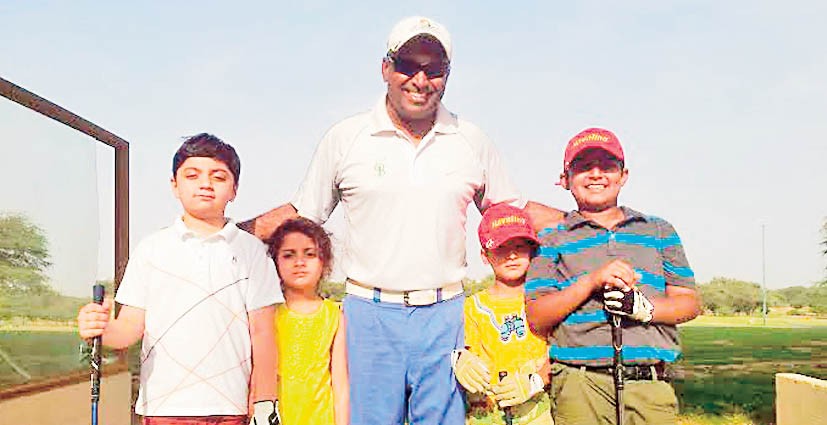
In a bid to help golfers, both beginners and the ones needing expert advice, TNS launches a regular Q/A column

In any sport, coaching plays a big role in a player’s bid to improve his game. In golf, it perhaps plays a huge role considering that it’s a technically tough sport.
Over the years, I’ve seen numerous golfers both in Pakistan and abroad, buying really expensive equipment with the belief that it would help them improve their game. But they should know that it’s the swing that really matters. Only if you know how to swing well can you hit properly, with any club. That’s the only way one can become a low handicapper. In any case, lessons from a coach cost far less than new equipment, at least in Pakistan.
In a bid to help golfers, both beginners and the ones needing expert advice, we’ve started a regular Q/A column in The News on Sunday.
Question 1: I play as a 10-handicapper and want to improve to become a single handicap player. Please suggest things I can do to improve my game?
Rehan Ahmed Khan
California, USA
JB: The best way to improve your game is by taking golfing lessons. The first lesson should be a course lesson, where the coach observes your game in general to unearth your strengths and weaknesses.
Most coaches prefer giving lessons on the golf range instead of the course, which is incorrect. The flaws are far more obvious on the course.
If a probationer comes to me for a lesson, I take him to the course for an hour or so of free-play, record a video of his swing technique and show it to him in slow motion, as it allows both of us to pluck out the flaws in his game. Once we have all the shortcomings at hand, we can plan on further lessons to improve them.
Question 2: I am a good hitter of the ball but I struggle to score on the course, what should I do?
Zubair Ali Shah
Peshawar
JB: I am sure you’re struggling due to untaught course management. The basics teach you to hit the fairways, keep the ball in play as it is the first golden rule. It’s not about hitting the ball long or hard, it’s about keeping it in play.
Architects of the game design different and difficult golf courses to test the skills and techniques of seasoned players. A good golfer always plans his shots. Being a professional golfer, I always planned mine. I used to stand on the tee, look right, left and straight and then decide the club I wanted to use.
Just like a photographer knows the good and the bad side of the portrait he’s capturing, a capable golfer knows his unfavourable side. For example, during my whole career, I hit fade shots to avoid water or OB (out of bounds) because I knew I’d hit the ball out of play if I went from left to right.
As I mentioned above, without taking proper individual lessons there is no way you can take a shot at becoming a professional golfer. You can read books or watch videos on the internet, but the truth is only a coach can nourish the technical aspects and fundamentals of your game.
If you watch professional golfers, they don’t attempt to hit the driver on every whole. They try to stay on the fairways as much as they can, so that it’s possible to hit the greens. Eventually, this is how your putting will improve, gaining positive energy from striking the ball.
Question 3: I am a beginner, what sort of a plan should I impose on myself? I only get two days to play golf.
Ali Asgher Khandwala
Karachi
JB: I would suggest practicing once a week on the range first. At least hit a few buckets with the complete set of clubs, giving special attention to the club you aren’t hitting well with, to gain that extra bit of confidence.
Importantly, keep those clubs in your golf bag so you don’t get double minded during play.
After thumping balls on the range, the best scenario for golfers is to go play the ‘Par three course’ at the Karachi Golf Club. It’s perfect for a short game where you can hit all sorts of shorter shots including the chip shots, pitches, bunker shots and putting. To finish all 9-holes of the par 3s takes about 20 minutes tops.
Secondly, it is compulsory for you to play on the course at least once a week, playing golfers better than you. This endeavor will buff your golfing skills and develop a sense of course management with towering confidence.
Questions 4: How can I improve my putting technique?
Shahrukh Masood
Karachi
JB: Step 1: Adjusting the line.
Step 2: Calibrating the length.
Step 3: Reading the Greens.
Step 4: Knowing your dominant eye.
Stated above are the four most important fundamentals of proficient putting, the rest lies in constant practicing to get a hold of your stroke and putting surface.
When you’re playing golf in Karachi, you’re dealing with slow greens, which is thick in the summers. And in the quick and fleeting winters, the green’s speed improves due to lack of growth on course.
Use a heavy putter if your putter isn’t hefty enough. You can also put lead-tape on the back or top of your putter to give it temporary weight.
Secondly, most golfers that I’ve taught over the years are fond of good soft putting strokes. The best advice on slow greens is to keep your back swing short and accelerate along the putt with a short follow through.
Think of hitting the ball closer to the hole. If you read the green correctly, adjust your line and calibrate the length, you’re bound to make a lot of putts.